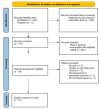Antioxidant Actions of Melatonin: A Systematic Review of Animal Studies
- PMID: 38671887
- PMCID: PMC11047453
- DOI: 10.3390/antiox13040439
Antioxidant Actions of Melatonin: A Systematic Review of Animal Studies
Abstract
Melatonin is an indoleamine with crucial antioxidant properties that are used to combat inflammatory and neoplastic processes, as well as control transplants. However, the clinical applications of melatonin have not yet been fully consolidated in the literature and require in-depth analysis.
Objectives: This study reviewed the literature on the antioxidant properties of melatonin in rat models.
Methods: We followed the guidelines of the Preferred Reporting Items for Systematic Reviews and Meta-analyses and used the PubMed, LILACS, and Cochrane databases, Google Scholar, and article references, irrespective of publication time.
Results: Ten articles involving 485 rats were selected, and the effects of melatonin on antioxidant markers were investigated. Melatonin increased superoxide dismutase in nine studies, glutathione peroxidase in seven studies, and catalase in five studies. In contrast, melatonin reduced glutathione in three studies and malonaldehyde in seven of eight studies.
Conclusion: Our findings suggest that melatonin effectively reduces oxidative stress.
Keywords: antioxidant; melatonin; nitrosative stress; oxidative stress; superoxide dismutase.
Conflict of interest statement
The authors declare no conflicts of interest.
Figures



References
-
- Tan D.X., Chen L.D., Poeggeler B., Manchester L.C., Reiter R.J. Melatonin: A potent, endogenous hydroxyl radical scavenger. Endocr. J. 1993;1:57–60.
Publication types
Grants and funding
LinkOut - more resources
Full Text Sources

